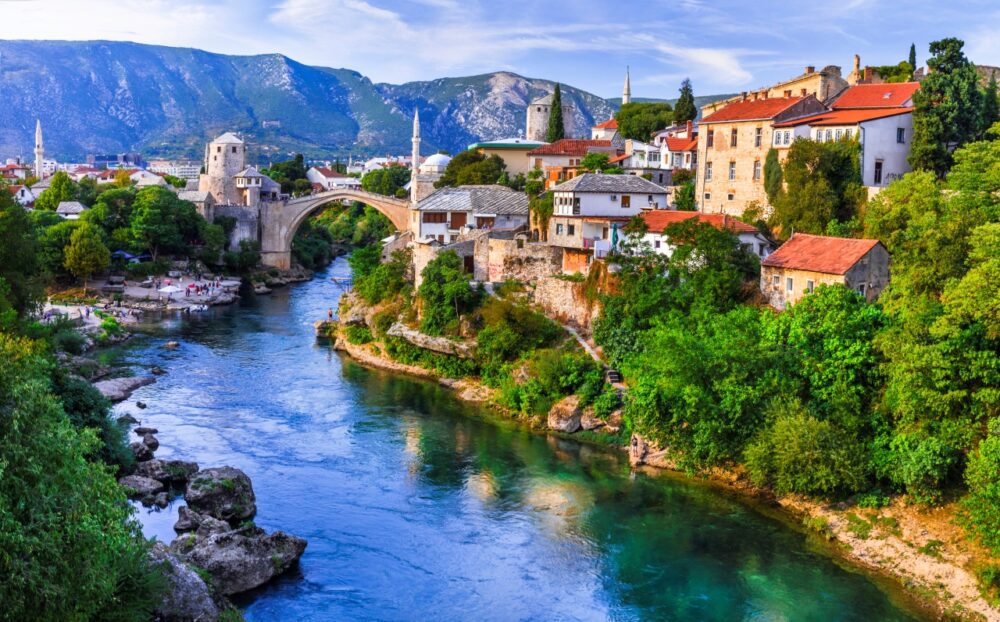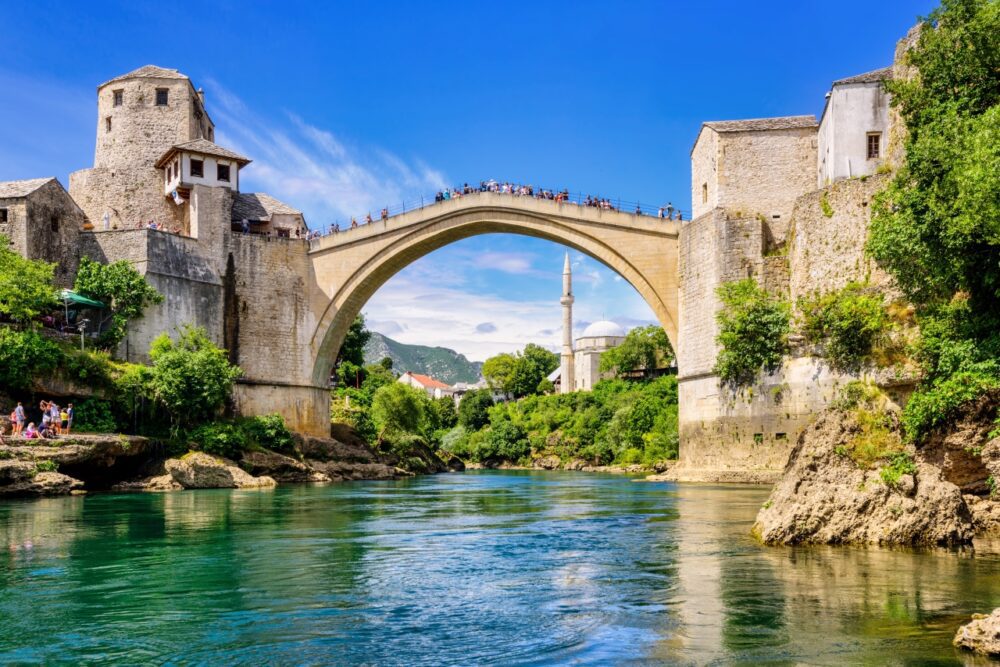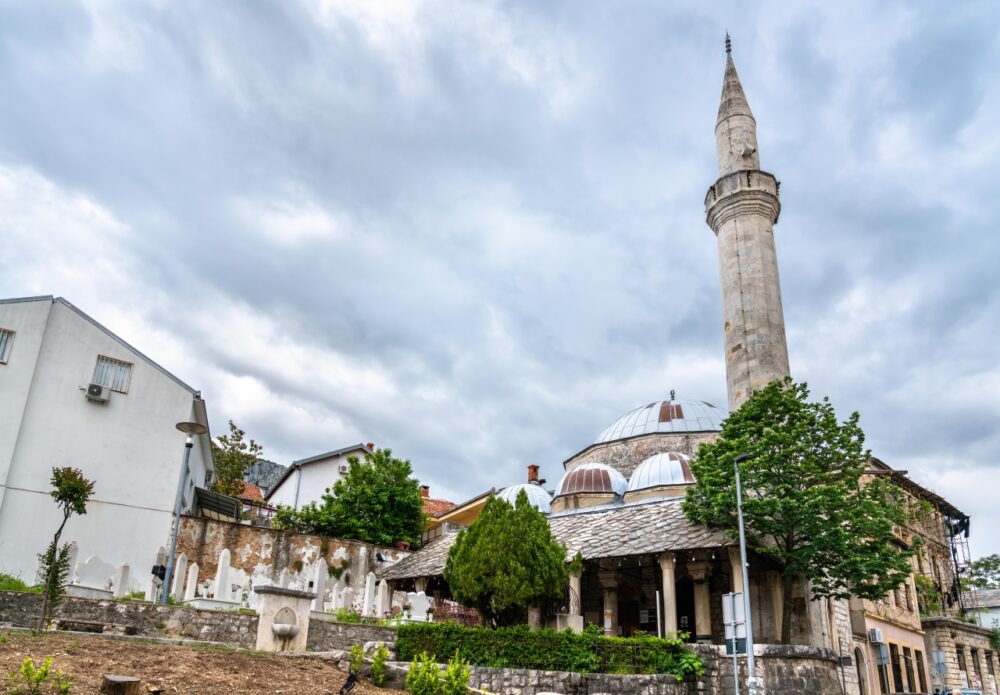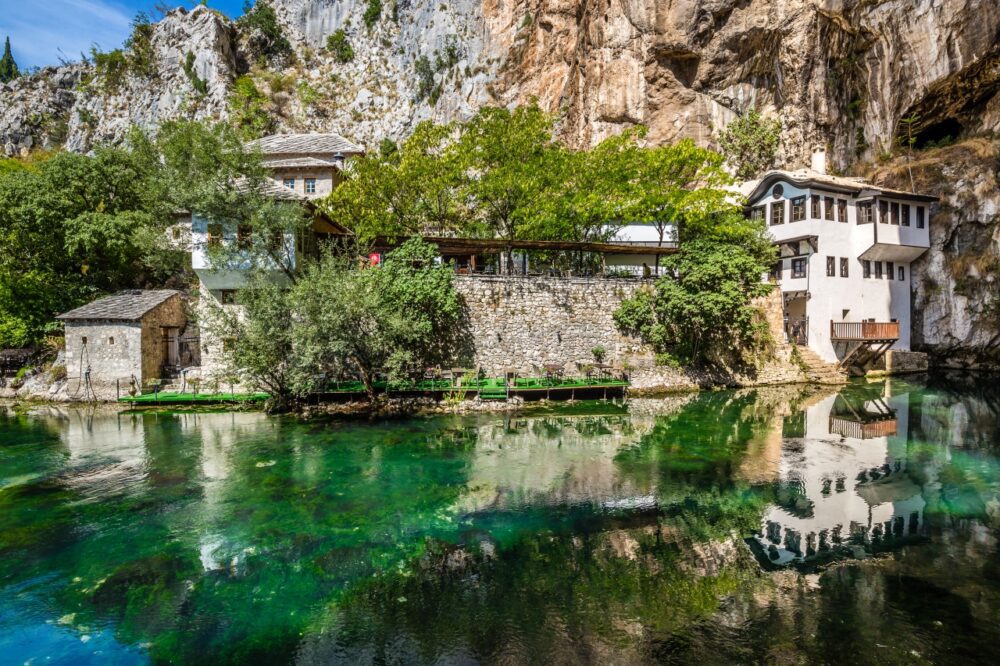
Mostar, one of Bosnia and Herzegovina’s most iconic destinations, is a city that instantly captures the heart. Famous for its stunning Stari Most (Old Bridge) and the turquoise waters of the Neretva River, Mostar offers a blend of history, culture, and breathtaking scenery. Whether you’re exploring the charming cobbled streets of the Old Town, watching daredevils dive from the bridge, or enjoying traditional Bosnian cuisine by the river, Mostar is full of unforgettable experiences. But with so many gems in the Balkans, you might wonder: is Mostar worth visiting? In this post, we’ll explore what makes Mostar unique and help you decide if it’s the right stop for your journey.
Table of Contents
Pros – Reasons You Should Visit Mostar
1. The Stunning Stari Most (Old Bridge) is One of Europe’s Most Iconic Landmarks

Mostar’s most famous attraction, the Stari Most (Old Bridge), is one of the most recognizable and beautiful bridges in Europe. Originally built by the Ottomans in the 16th century, it was tragically destroyed during the Bosnian War but was meticulously reconstructed in the early 2000s. Today, it stands as a powerful symbol of resilience and unity.
When I first saw the bridge, I was struck by how perfectly it arches over the emerald-green Neretva River. The contrast between the stone bridge, the colorful buildings of the Old Town, and the dramatic mountains in the background made it one of the most breathtaking scenes I’ve ever encountered. Watching the local divers leap from the bridge into the river below was both thrilling and nerve-wracking—an unforgettable experience.
2. A Unique Blend of Ottoman and European Influences

Mostar’s history as a crossroads between East and West is visible in its architecture, culture, and way of life. The city was shaped by Ottoman rule, Austro-Hungarian influence, and its Yugoslav past, resulting in a fascinating mix of mosques, churches, stone buildings, and Turkish-style bazaars.
As I wandered through the cobbled streets, I felt like I had stepped into a living history book. One moment, I was admiring the domes and minarets of Koski Mehmed Pasha Mosque, and the next, I was passing charming Austro-Hungarian buildings that wouldn’t look out of place in Vienna. The combination of cultures makes Mostar one of the most visually and historically interesting cities in the Balkans.
3. Incredibly Affordable for Travelers
Compared to Western Europe, Mostar is an extremely budget-friendly destination. Accommodation, food, transport, and attractions are all very affordable, making it a great choice for travelers who want a rich cultural experience without spending a fortune.
I stayed in a cozy guesthouse just a short walk from the Old Bridge for a fraction of what I would have paid in other European cities. Meals at traditional restaurants were generously portioned and inexpensive—I had a delicious plate of cevapi (grilled meat sausages with flatbread) for less than the price of a coffee in London. Even guided tours and day trips were very reasonably priced.
4. A Fascinating and Emotional History
Mostar’s history is both beautiful and tragic. The city was heavily damaged during the Bosnian War in the 1990s, and the scars of the conflict are still visible in some areas. However, the way the city has rebuilt itself while preserving its history makes it an incredibly moving place to visit.
I took a walking tour with a local guide who shared personal stories about growing up during the war. Seeing bullet-ridden buildings and ruins alongside beautifully restored landmarks was a stark reminder of how far the city has come. If you’re interested in history, Mostar offers a deeply personal and eye-opening experience that stays with you long after you leave.
5. Breathtaking Natural Scenery and the Neretva River
Mostar is set in a stunning natural landscape, with the turquoise waters of the Neretva River flowing through the city and dramatic mountains rising in the background. The river is not just a scenic feature—it’s a key part of local life, providing a place to swim, fish, and cool off during the hot summer months.
I walked down to the riverbanks for a different perspective of the Old Bridge, and the reflections of the stone buildings in the water were mesmerizing. In the summer, locals and tourists alike gather along the river to relax, have picnics, and even take a dip in the refreshingly cold water. The mix of urban and natural beauty makes Mostar one of the most picturesque cities in the Balkans.
6. A Food Scene That Combines Balkan and Turkish Flavors
Bosnian cuisine is delicious, and Mostar is an excellent place to try traditional dishes influenced by both Balkan and Ottoman culinary traditions. Meat lovers will enjoy cevapi, while vegetarians can indulge in dishes like dolma (stuffed vegetables) and pita (flaky pastry filled with cheese, potatoes, or spinach).
One of my favorite meals was at a riverside restaurant where I tried a traditional Bosnian stew called begova čorba. It was rich, hearty, and bursting with flavor, making it the perfect comfort food after a long day of exploring. To top it off, I had tufahija, a delicious poached apple dessert, paired with strong Bosnian coffee. The food in Mostar is not only tasty but also incredibly affordable.
7. The Warmth and Hospitality of the Locals
Bosnians are known for their hospitality, and Mostar is no exception. Despite the city’s complex history, the people are incredibly welcoming, friendly, and happy to share their culture with visitors. Whether you’re asking for directions or sitting down for a meal, you’ll likely find yourself engaged in warm and genuine conversations.
I stopped at a small shop selling handmade crafts, and instead of just making a quick purchase, I ended up chatting with the owner for nearly an hour. He shared stories about his life, gave me recommendations for hidden spots in the city, and even offered me a cup of coffee. The kindness and generosity of the locals made my visit even more special.
8. A Compact and Walkable City
Mostar is small enough that you can see most of its main attractions on foot, making it easy to explore without relying on taxis or public transport. The Old Town is particularly pedestrian-friendly, with its narrow stone streets and charming alleyways.
I loved being able to walk from one historic site to another in just minutes, without worrying about long distances or complicated transport routes. Even the viewpoints, like the Koski Mehmed Pasha Mosque’s minaret, were within easy reach, allowing me to take in stunning panoramic views without much effort. If you enjoy cities that are easy to navigate, Mostar is ideal.
9. A Great Base for Day Trips to Stunning Nearby Destinations

Mostar is surrounded by incredible places that are well worth visiting. From waterfalls to medieval villages, there are plenty of easy day trips that add to the experience of staying in Mostar.
I took a short trip to Kravice Waterfalls, a breathtaking natural wonder where I swam in the crystal-clear pools and enjoyed the peaceful surroundings. Another great excursion was to the village of Blagaj, home to the stunning Blagaj Tekija, a 600-year-old Sufi monastery built against a dramatic cliffside. These day trips were quick, affordable, and added even more variety to my visit.
10. A Unique and Unforgettable Atmosphere
Mostar has a special energy that’s hard to describe. It’s a place where East meets West, where history and modern life intertwine, and where breathtaking landscapes provide the backdrop to centuries of cultural heritage. Despite its past struggles, the city has a spirit of resilience and beauty that makes it one of the most captivating places in Europe.
As I sat by the river at sunset, watching the last light of the day illuminate the Old Bridge while the call to prayer echoed in the distance, I realized that Mostar isn’t just a place to visit—it’s a place to feel. It’s a city that leaves a lasting impression, one that stays with you long after you’ve left.
Cons – Things to Consider When Visiting Mostar
1. The Summer Heat Can Be Overwhelming
Mostar is one of the hottest cities in the Balkans, and during the summer months, temperatures regularly climb above 40°C (104°F). The heat can be intense, especially when exploring the Old Town’s cobblestone streets, which retain warmth and make walking around feel even hotter. There’s also limited shade in some areas, making midday sightseeing quite challenging.
I visited Mostar in July, and by midday, I was desperately seeking refuge in a shaded café. Even standing on the Stari Most to watch the famous bridge divers became uncomfortable under the scorching sun. While the Neretva River provides a refreshing escape, and many restaurants offer shaded terraces, visiting in peak summer requires extra preparation—bringing plenty of water, wearing light clothing, and planning activities for early morning or late afternoon to avoid the worst of the heat.
2. The City Can Feel Overcrowded with Day Trippers
Mostar is a popular stop on many Balkan tour itineraries, which means that from late morning to early evening, the Old Town becomes packed with day-trippers arriving from Dubrovnik, Split, or Sarajevo. Large tour groups fill the narrow streets, and the area around the Old Bridge can feel extremely congested, making it difficult to fully appreciate the charm of the city.
I arrived in the late morning, and within an hour, the peaceful atmosphere had disappeared as busloads of tourists flooded the area. Shops, restaurants, and even scenic spots quickly became crowded, and getting a good photo of the bridge without dozens of people in the frame was nearly impossible. However, once the buses left in the early evening, Mostar transformed into a much quieter and more magical place. If you want to experience the city at its best, staying overnight and exploring early in the morning or after sunset is the way to go.
3. Signs of War Damage Are Still Visible
Although Mostar has been beautifully rebuilt in many areas, the scars of the Bosnian War are still evident in certain parts of the city. Bullet-riddled buildings, abandoned ruins, and war memorials serve as reminders of the conflict that devastated the city in the 1990s. While these remnants of the past add historical depth, they can also make parts of the city feel somber, especially for those unfamiliar with the region’s history.
Walking through Mostar, I noticed a stark contrast between the lively tourist areas and the quieter streets where damaged buildings remained untouched. Some locals are open to discussing the past, while others prefer not to revisit painful memories. While Mostar is a resilient and vibrant city, visitors should be mindful and respectful when encountering these reminders of its difficult history.
4. Limited Public Transport and Infrastructure Issues
Mostar is a small city, and while it’s very walkable, public transportation options are limited. There is no metro or tram system, and buses can be infrequent and difficult for tourists to navigate. If you plan to visit nearby attractions like Blagaj or Kravice Waterfalls, you may need to rely on taxis, rental cars, or organized tours.
I tried using the local bus system to get to Blagaj, but finding the correct bus stop and schedule was more complicated than expected. In the end, I opted for a taxi, which was much faster but also more expensive. While the compact size of Mostar means you won’t need transport within the Old Town, getting to surrounding areas requires some extra planning.
5. Some Parts of the Old Town Feel Too Touristy
While Mostar retains much of its authentic charm, parts of the Old Town have become highly commercialized, catering mainly to tourists rather than locals. Souvenir shops selling similar items line the streets, and some restaurants focus more on attracting visitors than offering genuinely local experiences. While this is common in many popular destinations, it can make certain areas feel less authentic.
As I walked through the bazaar, I noticed that many shops sold nearly identical trinkets, from keychains featuring the Old Bridge to mass-produced copper coffee sets. While there were still some artisan workshops with handcrafted goods, it took some effort to find them among the more generic tourist stalls. Dining can also be hit-or-miss—some restaurants focus on scenic views rather than high-quality food, so checking reviews beforehand is a good idea.
When to Visit Mostar
The best times to visit Mostar are spring (April to June) and autumn (September to October). These seasons offer mild weather, perfect for strolling along the cobbled streets and enjoying the views from the iconic Stari Most (Old Bridge). Summer (July to August) is the busiest time, with hot weather and bustling crowds, but the lively atmosphere and vibrant festivals make it worthwhile. Winters (December to February) are quieter, though some attractions may have limited hours, and cooler temperatures lend a tranquil charm to the city.
How to Get to Mostar
The nearest airport is Mostar International Airport (OMO), though flights are limited. Most visitors fly into Sarajevo International Airport (SJJ) or Dubrovnik Airport (DBV) in Croatia. From Sarajevo, buses and trains run regularly to Mostar, taking about 2-3 hours. From Dubrovnik, a 2-hour bus ride offers scenic views along the Adriatic coast. For those driving, the roads connecting Mostar to other Balkan cities are well-maintained, and the journey itself is often breathtaking.
Where to Stay in Mostar
Mostar offers a range of accommodations to suit every budget:
- Luxury: Near the Old Bridge – Stay at Hotel Mepas, a modern five-star option with excellent facilities, or Hotel Kapetanovina, offering comfort and views of the Neretva River.
- Mid-range: Around the Old Town – Consider Hotel-Restaurant Kriva Ćuprija, a boutique gem in a historic building, or Villa Fortuna, known for its charming garden and central location.
- Budget: Residential Areas or Guesthouses – Try Hostel Miran, a friendly and affordable choice for backpackers, or Pansion Cardak, a cosy guesthouse with warm hospitality.
Getting Around Mostar
Mostar is a compact city best explored on foot, especially the Old Town and its iconic attractions like Stari Most and the Koski Mehmed-Pasha Mosque. For longer distances or visits to nearby sites, local taxis are affordable, though it’s wise to confirm the fare beforehand. Renting a bike is another option for exploring the surrounding countryside. For day trips to spots like Blagaj Tekija or the Kravica Waterfalls, organised tours or rented cars offer convenience and flexibility.
How Long to Spend in Mostar
Two days is ideal for experiencing Mostar’s highlights. Spend the first day exploring the Old Town, visiting Stari Most, the Old Bazaar, and the War Photo Exhibition. Enjoy traditional Bosnian cuisine at a riverside restaurant. Dedicate the second day to exploring nearby attractions, such as the mystical Blagaj Tekija monastery or the stunning Kravica Waterfalls. With more time, take a scenic drive through the Neretva River Valley or explore nearby villages. Mostar’s mix of history, culture, and natural beauty ensures an unforgettable experience.
Conclusion
So, is Mostar worth visiting? Absolutely! If you’re captivated by historic charm, stunning landscapes, and a city that tells a story of resilience, Mostar is a must-see. Its iconic bridge, welcoming atmosphere, and proximity to other beautiful sites like Kravice Waterfalls make it a fantastic addition to any Balkan itinerary. While it can get crowded during peak season, the beauty and authenticity of Mostar make it more than worth the trip. For those seeking a mix of history, culture, and natural beauty, Mostar is a destination that’s sure to leave a lasting impression.
